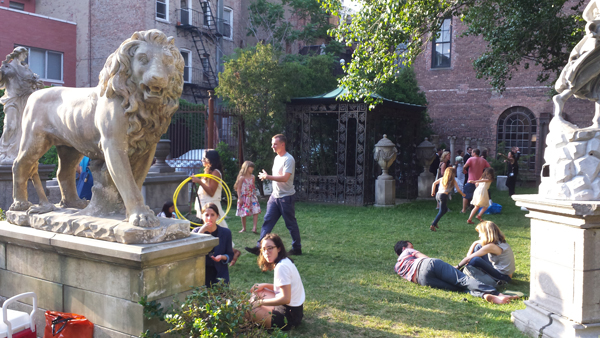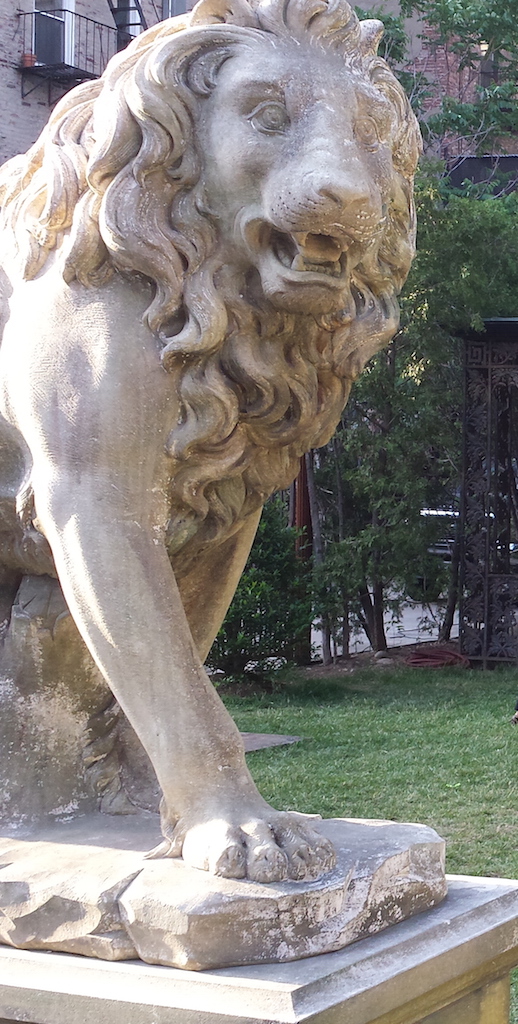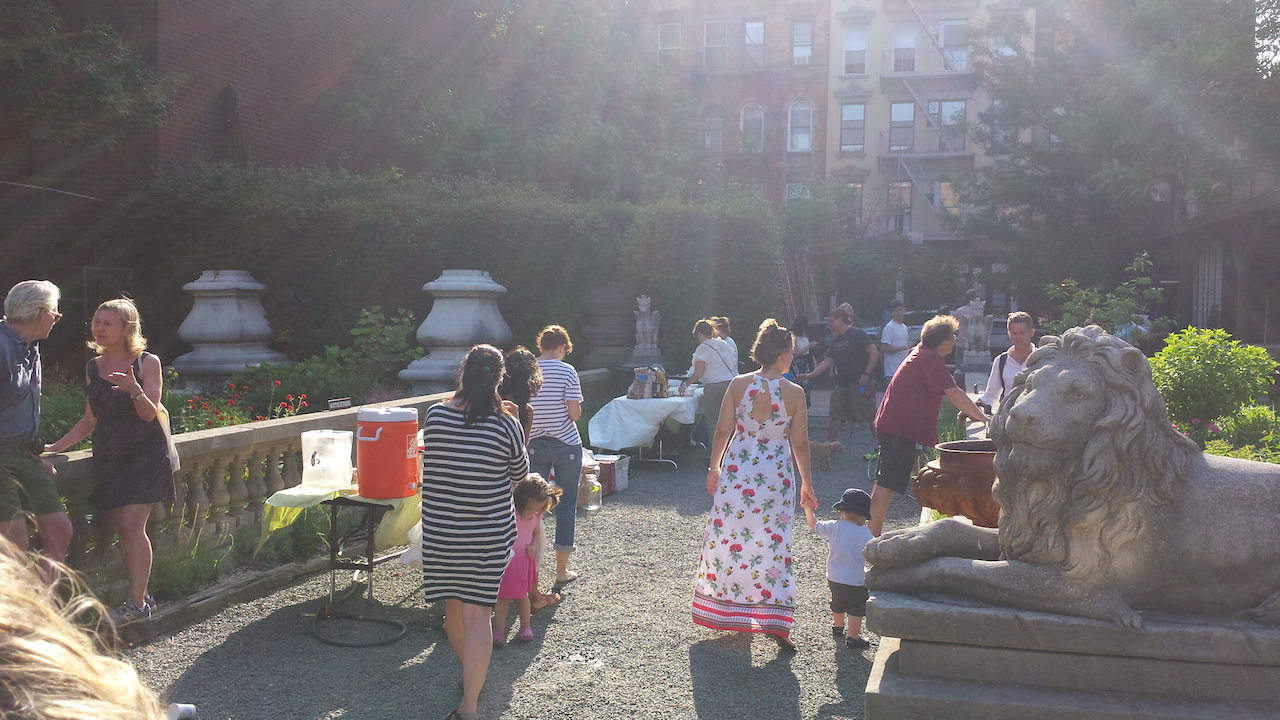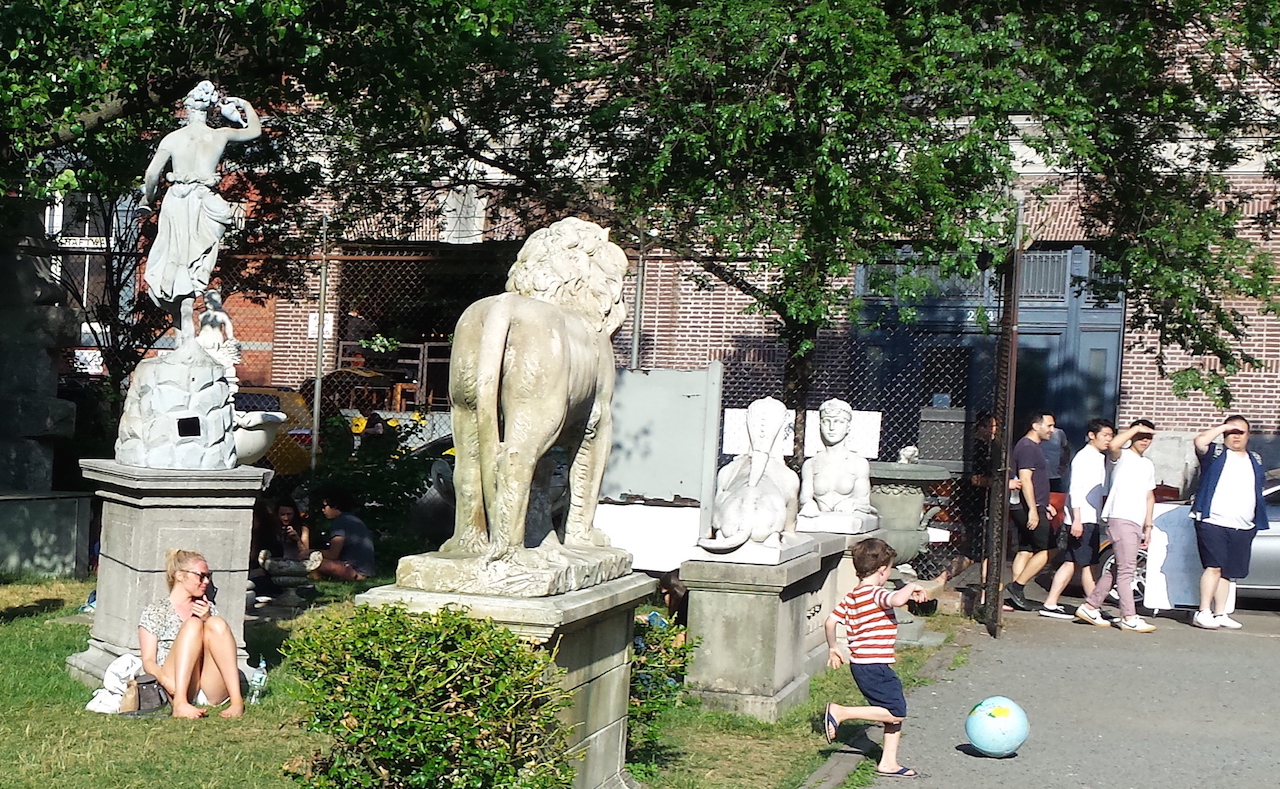
BY LINCOLN ANDERSON | While it’s abundantly clear that the Elizabeth St. Garden has rapidly become a much-loved community space in Little Italy, how the garden came to be is not as well known.
Supporters of the city’s plan to build a $24 million affordable housing project on the half-acre site dismiss the garden as a mere outdoor showcase for pricey private sculptural pieces and ornaments.
However, Allan Reiver, who has leased the lot from the city since 1991, said the garden is about a lot more than that.
He moved to the area in 1989. His apartment, on the east side of Elizabeth St., directly overlooks the space, which back then was a garbage-strewn lot. The block at that time sported a pair of 24-hour commercial bakeries, and a building on the corner of Prince St. whose five upper floors were all vacant and derelict.
“In all of Little Italy, it was the only block that was totally dilapidated,” Reiver recalled.
“I looked out my window and I saw the mess and then I heard it was going to be sold as a parking lot,” he recalled of the empty lot.
The spot had formerly housed a public school, and was planned to get a new one. But Little Italy residents protested and killed the project.
Reiver, 72, who was “a developer in a past life,” as he put it, had collected valuable monuments and pieces from historic estates to be used in his projects. He had the idea of displaying them in the open-air lot.
“The lease originally called for it to just be storage, but I decided to make it a garden,” he said. “Everything in there, I planted. I built the garden.”
The garden’s signature pieces are its lions, probably 19th- or 20th-century copies of Italian originals, he said. The gazebo is from a garden designed by Frederick Law Olmsted, the famed landscape architect who created Central Park and Prospect Park. Historic balustrades from Lynnewood Hall, a Gilded Age mansion in Philadelphia, line the garden’s pathways.
“Everything’s very significant,” he said of the garden’s pieces. “They’re all displayed in a very thoughtful manner. It’s not a random jumble. It’s all carefully placed.”
Until the summer of 2012, however, neighborhood park activists didn’t realize that the garden was on city-owned land. As soon as they did, they mobilized to gain access to it and have since turned it into a thriving community hub in open space-starved Little Italy.
As reported by The Villager last week, former Parks Commissioner Adrian Benepe strongly supports saving the garden, describing its effect on the neighborhood as nothing short of “transformational.”
Assemblymember Deborah Glick and state Senator Daniel Squadron also oppose the housing project at the site, saying the garden should be preserved. Meanwhile, City Councilmember Margaret Chin and the city are pushing for the housing.
Reiver has been all for allowing public access to the garden, and is an enthusiastic supporter of turning the spot into permanent parkland, as advocated by Community Board 2. As for why he didn’t allow the public into the place before, he said the conditions weren’t right.
“The front door to your home is not open to the public, either,” he noted.
But once a group of volunteers emerged to run the garden as a public space, he got on board with the idea right away.
“Now there was a group of volunteers,” he said. “Before, there was a question of liability, of kids falling over…vandalism. Not so much theft — it’s hard to steal 2,000-, 3,000-pound monuments. That people would be sleeping in there was a concern.
“I planted trees and planted grass. But if the gates had been wide open, it would have been filled with garbage again in a week or two. It’s human nature.
“Now the garden is open when volunteers are there to supervise it,” he said. “They maintain it, clean it, and it’s doing beautifully.”
Reiver rents out the garden for a few events per year, usually two or three, such as weddings, he said. In 2005, he opened his gallery in a former firehouse adjacent to the garden.
Both the garden and gallery are “highly, highly curated,” he stressed. The gallery features objects like an old kayak skeleton and an early airplane.
The garden’s official operating hours are Wednesday to Sunday, noon to 6 p.m., but it’s been open more than that — whenever a volunteer decides to pick up a key at the gallery and open up the gate — he said.
The garden will hold its third annual Harvest Fest on Sat., Oct. 24, from noon to 4 p.m. The event is free and open to the public.
Replacing the garden with housing means the open space would be lost forever, Reiver said. On the other hand, housing can always be built at another location — such as at a far larger site identified by Tobi Bergman, chairperson of Community Board 2, at Hudson and Clarkson Sts.
“I don’t think there’s any question,” Reiver said, “nobody in New York City will ever tear down a building to create a park. And once the park is destroyed, it’s destroyed forever.
“I was a developer for many years and I was a lawyer, as well, and there’s a simple solution to the problem of affordable housing,” he offered. “You merely require that anyone building housing provide a certain amount of affordable housing. In return, you give them additional F.A.R.,” he said, referring to “floor area ratio,” which is the amount of allowable development square footage.
In fact, the de Blasio administration currently is proposing to do exactly this, but only for districts or specific projects where a rezoning is involved — as opposed to all building projects, in general.
Reiver has been paying the city the same rent for the garden lot since 1991 — $4,000 a month, or $48,000 a year.
He said he sells about one or two of his pieces from the garden each year. However, the garden is really a “branding mechanism” for the gallery, he said, which actually does most of its business online and from a warehouse.
“I could have very easily stored stuff on top of dirt and gravel,” he said of the garden. “It was a way of creating something beautiful. It was an ugly lot and I could make it pretty. I did it in 1991 because I lived across from it and it looked like s—.”
Reiver direly predicted, “If you’re going to build on the Elizabeth St. Garden, Central Park will be next. If you look in the history books, you’ll find three or four proposals to develop buildings in Central Park.”




















